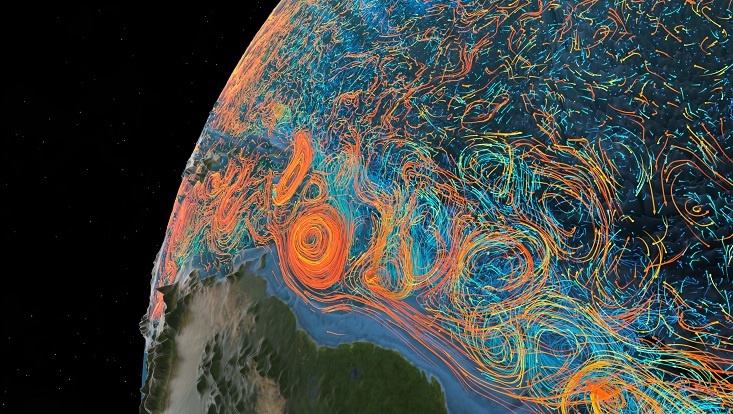Following the upper and lower limbs of the AMOC (Atlantic Meridional Overturning Circulation)

Following the upper and lower limbs of the AMOC (Atlantic Meridional Overturning Circulation)
Due to large incoming solar radiation in tropical regions, the upper layers of the Atlantic Ocean gain heat at low latitudes. Ocean currents are set in motion to re-distribute this heat to higher latitudes, warming up the atmosphere along their path and contributing to mild weather conditions over Europe. This corresponds to the upper limb of the Atlantic meridional overturning circulation - AMOC for short. At high latitudes, the cooled and densified surface waters deepen into the ocean interior and return back south, making up the lower limb of the AMOC.
Let us follow the water movement along the AMOC by deploying and tracking ocean The length of the particle trails is proportional to the velocity of the ocean current and their color to the ocean temperature
Vigorous warm currents flow towards North along the western boundary of the Atlantic.
We start off the North Brazil Current, which first breaks up into strongly rotating circular eddies, then feeds the flow into the Caribbean Sea. Away from the boundaries, particle trails are shorter, meaning the velocities are weaker. In the Gulf of Mexico, the current makes a sharp turn into the Florida Straits and ends up in one of the largest current systems in the World: the Gulf Stream. Here, again, energetic eddies can be seen, rotating for a long time around their centers.
Some of the currents escape the eddies and flow towards east, continuing in the Azores Current and some move towards North.
Further north, the Gulf Stream continues as the weaker, less defined North Atlantic Current. A part of the flow continues to the Nordic Seas then partially recirculates in the subpolar north Atlantic, into the Labrador Sea. Along the way, the surface waters lose some of the heat and become cold, therefore dense. In the Labrador Sea, the harsh winter conditions make the surface water even colder and denser, to the point that it is heavier than the water below it and starts to plunge into the deep, in a process called convection. Once at depths around 1000 to 2000 meters, this water mass encounters water of similar densities and begins to flow to the south.
We now look only at currents below 2000 meters depth: the so-called Deep Western Boundary Current, which forms the lower limb of AMOC, can be observed starting at the southern tip of Greenland and following the continental slope. At the exit of the Labrador Sea, it goes around the Flemish Cap and enters the region below the Gulf Stream. The flow in the upper layers is so strong that currents deeper than 2000 m still feel this movement and are entangled into eddies. In contrast, directly at the boundary, currents progress slowly southwards.
The flow below 2000m south from the Gulf Stream eddy region is mostly confined to the continental slope and follows the bottom topography.
Along the South American continent, the continental slope is interrupted by large underwater promontories, which the Deep Western Boundary Current needs to circumvent. While going around them, meanders and eddies are generated; the flow becomes unstable.
One of those regions lies in the southern hemisphere, offshore the Brazilian coast. The flow is disrupted into eddies and from there onwards no longer flows as a well-defined current. The lower limb of the AMOC is from there onwards dominated by ocean eddies.
